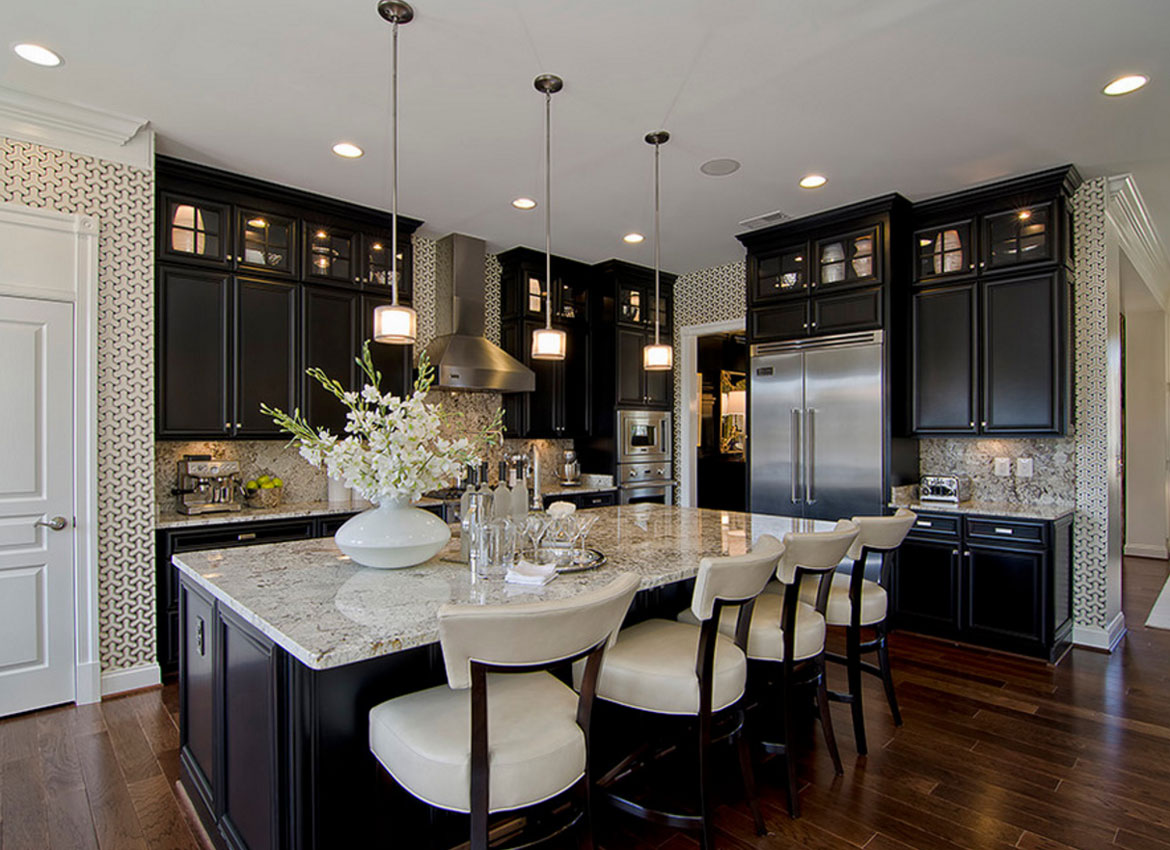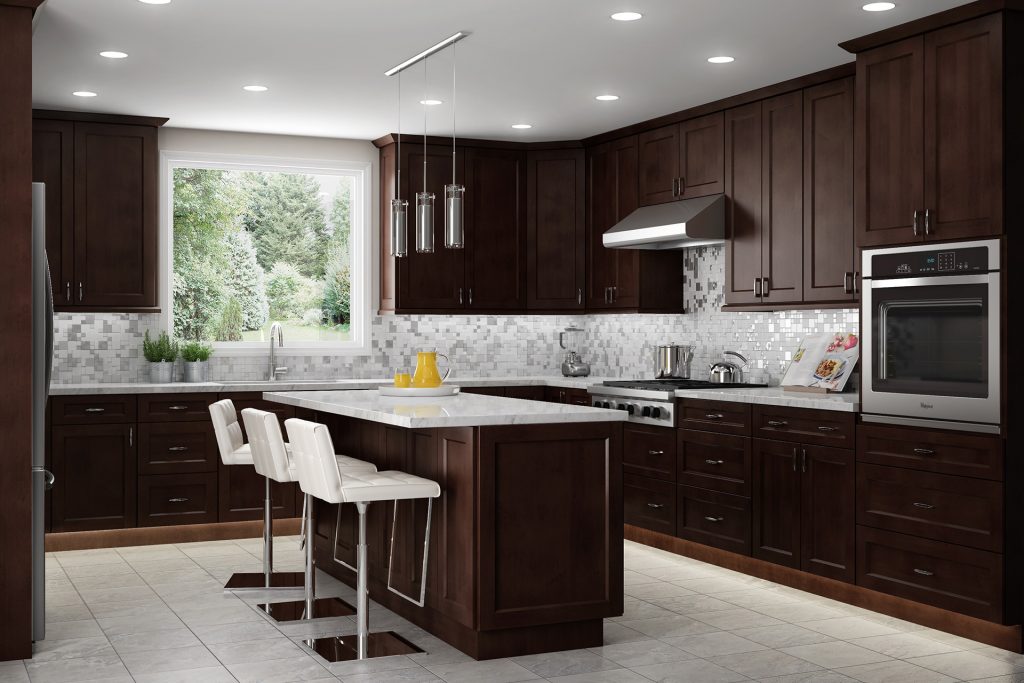Dark Kitchen Cabinets: Dark Kitchen Cabinets Decor

Dark kitchen cabinets are a timeless design element that can transform the look and feel of any kitchen. Their versatility allows them to seamlessly integrate into various design styles, from modern to traditional, adding a touch of sophistication and elegance.
Dark Cabinet Finishes: A Spectrum of Elegance
Dark kitchen cabinets offer a wide range of finishes, each contributing a unique character to the space. Popular choices include:
- Black: Black cabinets exude a bold and dramatic statement, creating a contemporary and sophisticated ambiance. They provide a striking backdrop for lighter countertops and appliances, enhancing the overall contrast and visual interest.
- Navy: Navy cabinets offer a touch of richness and depth, adding a sense of tranquility and sophistication to the kitchen. They pair beautifully with warm wood tones, metallic accents, and white countertops, creating a harmonious and inviting atmosphere.
- Espresso: Espresso cabinets are a popular choice for their versatility and ability to complement both modern and traditional kitchen styles. They offer a warm and inviting feel, providing a balanced backdrop for various countertop and appliance choices.
- Walnut: Walnut cabinets feature rich brown tones and intricate grain patterns, adding a touch of natural beauty and warmth to the kitchen. They create a timeless and elegant ambiance, complementing both contemporary and traditional design aesthetics.
Impact of Dark Cabinets on Kitchen Ambiance, Dark kitchen cabinets decor
Dark kitchen cabinets have a profound impact on the overall ambiance of the space, creating a sophisticated and inviting atmosphere. They:
- Enhance the Feeling of Spaciousness: Dark cabinets, especially when paired with light countertops and walls, can create an illusion of spaciousness, making the kitchen feel larger and more open. This is particularly beneficial in smaller kitchens, where maximizing the perception of space is crucial.
- Create a Sense of Depth and Dimension: The deep tones of dark cabinets add depth and dimension to the kitchen, making it feel more inviting and welcoming. This effect is further enhanced when combined with strategic lighting, which highlights the textures and details of the cabinets.
- Promote a Sense of Calm and Tranquility: Dark cabinets, particularly those with matte finishes, have a calming effect on the senses. They create a sense of tranquility and sophistication, making the kitchen a more relaxing and enjoyable space to cook and gather.
- Provide a Striking Backdrop for Decorative Elements: Dark cabinets serve as a beautiful backdrop for decorative elements, such as colorful artwork, plants, and statement lighting. The contrast between the dark cabinets and lighter accents creates a visually appealing and dynamic space.
Harmonizing Colors and Materials

Dark kitchen cabinets, with their rich and sophisticated appeal, offer a unique canvas for creating a stunning and functional kitchen space. The key lies in harmonizing the dark tones with complementary colors and materials that create a balanced and inviting atmosphere.
Complementary Color Palettes
A well-chosen color palette is crucial for achieving a harmonious kitchen design. When working with dark cabinets, it’s essential to incorporate light and neutral shades to prevent the space from feeling too heavy or oppressive.
- White: White is a classic choice that complements dark cabinets beautifully. It provides a clean and crisp contrast, creating a sense of spaciousness and brightness.
- Cream: A warmer alternative to white, cream offers a softer and more inviting feel. It pairs well with dark cabinets, especially in traditional or farmhouse-style kitchens.
- Gray: Gray is a versatile neutral that can be used to create a sophisticated and modern aesthetic. It complements dark cabinets without being too stark or overpowering.
- Beige: Beige adds warmth and sophistication to a kitchen. It pairs well with dark cabinets and can be used to create a cozy and inviting atmosphere.
Kitchen Layout with Contrasting Elements
To prevent a dark kitchen from feeling too closed in, it’s essential to incorporate contrasting elements that create a sense of balance and visual interest.
- White Countertops: White countertops provide a striking contrast to dark cabinets, adding brightness and spaciousness to the kitchen.
- Stainless Steel Appliances: Stainless steel appliances complement dark cabinets with their sleek and modern appeal. They also reflect light, helping to brighten the space.
- Light-Colored Backsplashes: Light-colored backsplashes create a visual break between the dark cabinets and the countertops, adding depth and dimension to the kitchen design.
Countertop Materials
The choice of countertop material plays a significant role in harmonizing the overall design of a kitchen with dark cabinets.
| Material | Description | Benefits |
|---|---|---|
| Quartz | Engineered stone made from quartz crystals and resin. | Durable, scratch-resistant, stain-resistant, and available in a wide range of colors and patterns. |
| Granite | Natural stone known for its unique veining and durability. | Heat-resistant, scratch-resistant, and comes in a variety of colors and patterns. |
| Butcher Block | Wood countertop made from hardwood planks. | Warm and natural, durable, and can be refinished over time. |
Illuminating the Space

Dark kitchen cabinets can create a dramatic and sophisticated atmosphere, but they also present a unique challenge when it comes to lighting. Proper illumination is crucial to prevent the space from feeling too dark or gloomy, while also highlighting the beauty of the cabinets and showcasing the overall kitchen design.
Dark kitchen cabinets decor – To effectively illuminate a kitchen with dark cabinets, a well-planned lighting strategy is essential. This involves incorporating a mix of ambient, task, and accent lighting, each serving a specific purpose to create a functional and visually appealing space.
Ambient Lighting
Ambient lighting provides the overall illumination for the kitchen, setting the mood and creating a comfortable atmosphere. It should be soft and diffused, avoiding harsh shadows that can make the space feel claustrophobic.
- Recessed Lighting: Recessed lights are a popular choice for ambient lighting, providing even illumination throughout the kitchen. They can be strategically placed to create a balanced and well-lit space.
- Pendant Lights: Pendant lights, especially those with a wider, diffused light source, can offer a stylish and functional ambient lighting solution. They can be hung over islands or dining areas, providing a soft and inviting glow.
- Chandeliers: For a more dramatic and elegant ambiance, a chandelier can serve as a statement piece while providing ambient lighting. Choose a chandelier with a design that complements the dark cabinets and overall kitchen style.
Task Lighting
Task lighting provides focused illumination for specific activities, such as preparing food, cleaning, or working at the kitchen counter. It should be bright and directed, making it easier to see what you’re doing.
- Under-Cabinet Lighting: Under-cabinet lights are essential for task lighting, illuminating the countertops and work areas. They can be LED strips, puck lights, or linear fixtures, offering various styles and levels of brightness.
- Pendant Lights: Pendant lights with focused beams can also serve as task lighting, especially over islands or dining tables. They can be adjusted in height to provide optimal illumination for specific tasks.
- Track Lighting: Track lighting offers versatility, allowing you to direct the light where it’s needed. It’s particularly useful for illuminating work areas, showcasing artwork, or highlighting architectural features.
Accent Lighting
Accent lighting is used to highlight specific features and create visual interest. It can be used to draw attention to architectural details, artwork, or display items, adding depth and dimension to the space.
- Sconces: Sconces mounted on walls can provide soft, directional light, highlighting artwork, decorative items, or specific areas of the kitchen.
- LED Strip Lights: LED strip lights can be used to create dramatic backlighting effects, illuminating the backsplash, showcasing the cabinetry, or highlighting shelves.
- Pendants or Chandeliers: Pendants or chandeliers with a decorative design can serve as accent lighting, adding a touch of elegance and drawing attention to a particular area of the kitchen.
Dark kitchen cabinets are a classic choice for a reason. They create a sense of sophistication and drama, and they can make a space feel cozy and inviting. When paired with light countertops, they offer a stunning contrast that’s both elegant and timeless.
If you’re considering this classic combo, check out light countertops and dark cabinets for some inspiration. The key to pulling off this look is to choose the right shade of dark for your cabinets and to add in some lighter accents to balance out the darkness.
Dark kitchen cabinets can be a stunning focal point, adding a touch of sophistication and drama to your space. If you have oak cabinets that you’d like to darken, you can achieve a similar effect by staining them. Check out this helpful guide on how to stain oak cabinets darker for a seamless transformation.
Whether you choose a rich espresso or a deep charcoal, dark kitchen cabinets will instantly elevate the ambiance of your kitchen.